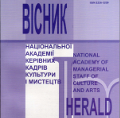МОДЕЛЬ ТІЛЕСНОСТІ «БУДЕННЕ ТІЛО» В ТЕОРЕТИКО-ПРАКТИЧНІЙ СПАДЩИНІ МЕРСА КАННІНГЕМА
"EVERYDAY BODY" MODEL OF PHYSICALITY IN THEORETICAL AND PRACTICAL HERITAGE OF MERCE CUNNINGHAM
Author(s): Olha BabichSubject(s): Theatre, Dance, Performing Arts, Sociology of Culture, Post-War period (1950 - 1989)
Published by: Національна академія керівних кадрів культури і мистецтв
Keywords: modern dance; postmodern dance; physicality; model of physicality "everyday body"; M. Cunningham;
Summary/Abstract: The purpose of the article is to reveal the peculiarities of the formation of the "ordinary body" model of physicality in the postmodern dance system based on the analysis of the theoretical and practical legacy of Merce Cunningham. Research methodology. The analytical method, the methods of analysis and synthesis, the typological, dialectical and comparativist method were applied, which contributed to the clarification of the place and role of physicality in certain philosophical and cultural positions, to the study of the problem of physicality in general and the "everyday body" model in the concept of representatives of postmodern dance, consideration of theoretical – the practical legacy of M. Cunningham, the understanding of the internal relationship between the categories "body" and "physicality" in modern dance. Scientific novelty. The conceptual construct of corporeality, formulated within the framework of postmodern dance, is analysed; the cultural-historical model of physicality "everyday body" was characterised and the features of its representation in postmodern dance practices were revealed; changes in the perception of physicality in the context of the transformation of the sociocultural space of the 50s and 60s of the 20th century are analysed. The understanding of corporeality in the theoretical and practical discourse of postmodern dance by M. Cunningham is considered. Conclusions. At the core of the postmodern system is the principle of randomness, which is positioned as an artistic expression of the involvement of many bodies in the space of action of forces independent of them. In search of ways to free oneself from bodily canons that were formed in the sociocultural space, Merce Cunningham methodologically used randomness as the principle of creating a new dance corporeality, which lacks a coherent image and becomes a flow. In the process of constant experiments, the choreographer's own idea of what dance is (how it feels in the body and how it looks on stage) evolved. M. Cunningham's activities allowed him to overcome the limitations of his own taste and give priority to "movement for the sake of movement" – the dance no longer conveyed the story, emotions or characteristics of the characters. The choreographer completely departs from established dance lexicons, discovering innovative ways of organising and representing bodies in space and time by means of random operations. Taking into account these and numerous additional innovations, in the history of postmodern dance, M. Cunningham exerted the greatest influence on the formation of the "everyday body" model of physicality.
Journal: Вісник Національної академії керівних кадрів культури і мистецтв
- Issue Year: 2023
- Issue No: 4
- Page Range: 20-25
- Page Count: 6
- Language: Ukrainian

